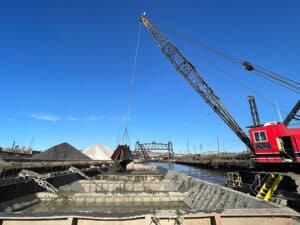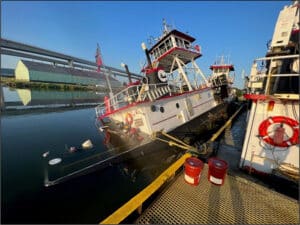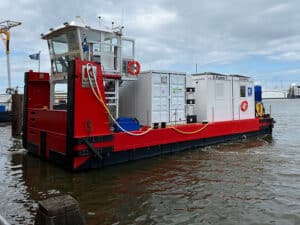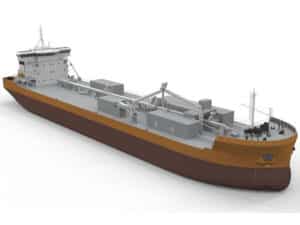
USACE breaks ground for new lock chamber at Lock and Dam 25
Written by Marine Log Staff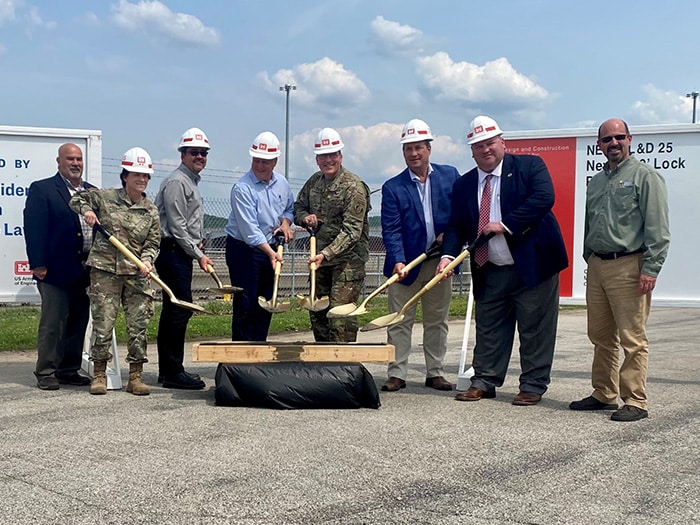
Groundbreaking ceremony at Lock and Dam 25 paves way for start of construction of a new 1,200 foot lock chamber.
The St. Louis Engineer District held a groundbreaking ceremony May 18 for a new 1,200- by 110-foot lock chamber adjacent to the existing 600- by 110-foot lock chamber in Winfield, Mo.
The original Lock 25 opened May 18, 1939, as the third to the last lock built in the Mississippi River system and passes approximately 23 million tons of commercial commodities through annually. Eighty-four years later, the St. Louis District along with several dignitaries held the official kick off to welcome the new construction of the additional lock chamber that will allow for two-way traffic and the construction of a fish passage structure at Lock 22 in Saverton, Mo.
Located in Winfield, Mo., (45 miles north of St. Louis), Lock and Dam 25 was selected for upgrades due to its location through the Bipartisan Infrastructure Law signed into law in November 2022. The $829 million funding for the Mississippi River locks and dams upgrade is part of the Navigation and Ecosystem Sustainability Program (NESP) which will include the construction of a new 1,200-foot lock, as well as an environmental restoration project at Lock & Dam 22 and other small-scale ecosystem and navigation projects in the region.
The St. Louis District maintains a depth of at least nine feet by using dams to create pools (lakes), as well as by dredging and river training structures. The Corps operates locks 24 hours a day, seven days a week to allow vessels to pass from one pool to another. For commercial vessels, the capacity of the Mississippi River navigation system is limited by the existing lock facilities.
“Most every bushel of soybeans, corn, and other grain transported along the Mississippi River from the states of Illinois, Iowa, Minnesota, Missouri, and Wisconsin will pass through Lock and Dam 25 en route to export facilities near the Gulf of Mexico,” commented Mike Steenhoek, executive director of the Soy Transportation Coalition, who attended the ceremony.
He added that the NESP program calls for the construction of seven new locks – five north of St. Louis on the Upper Mississippi River and two on the Illinois River (LaGrange and Peoria) and said that the new lock chamber at Lock and Dam 25 will enable a typical fifteen barge tow – transporting over 800,000 bushels of soybeans – to transit the lock in one single pass (a 30-45 minute process) compared to disassembling the barge tow into two sections, which will result in two passes (over two hours). In addition, a second lock will provide needed resiliency and redundancy – allowing a key link in the supply chain to remain operational if one of the lock chambers was closed.
“Other nations have inland waterways,” said Steenhoek. “However, one of the reasons our inland waterways are so unique is that they are adjacent to some of the most productive farmland on the planet. As a result, many farmers throughout the country have close access to a marine highway that can effectively transport soybeans, grain, and other commodities to export terminals, which allows us to be so competitive. It is therefore a most welcome development to move forward with the enhancement of such a critical link in agriculture’s supply chain. Agriculture, the barge and towing industry, and all stakeholders should be commended for helping make this happen.”
“The new 1,200-foot lock is nationally critical infrastructure and the reliability of this critical link in the Inland Waterways Navigation System is essential to U.S. agriculture and National Security, significantly reducing delays and increasing safety,” St. Louis District Commander, Col. Kevin Golinghorst said.
Phase 1 construction at Lock and Dam 25 is scheduled to be completed in Spring 2024. The design for the remainder of the project is ongoing and is expected to be completed by Summer 2026. Construction for the reminder of the project is expected to begin shortly after design is completed and is currently forecasted to be completed and commissioned in 2034, pending further input from contractors. There are other work features that are being prepared in advance for the major construction efforts; these include, site access upgrades, steel bulkhead fabrication and navigational aids.
The St. Louis District is also pursuing design and construction utilizing Integrated Design and Construction methodologies that would allow the early integration of the construction contractors input through the design process. This would allow better integration and coordination between the designers, navigations stakeholders and the construction contractor.

